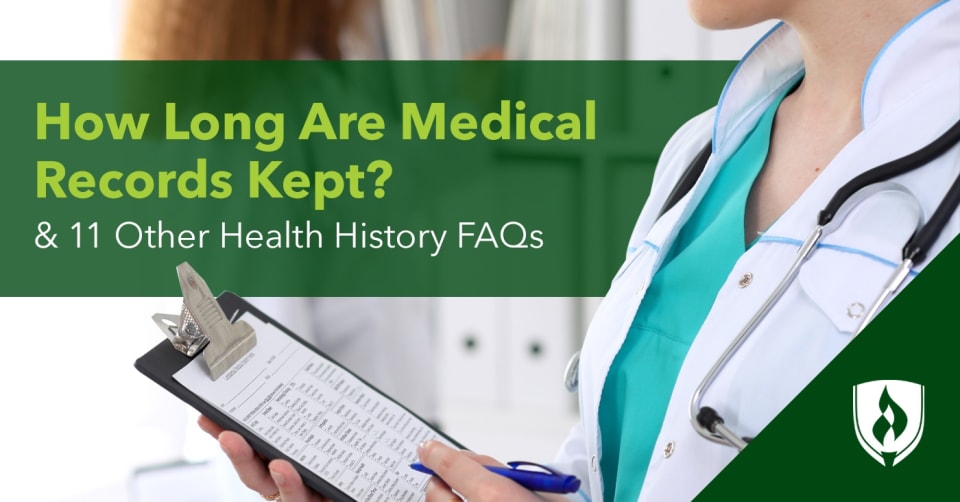
Here’s a riddle. It’s something that follows you through life but has no legs. Some are short, and some are long. It’s not invisible, but you rarely see it. What is it?
Did you figure it out? It’s a medical record. And while we all see doctors throughout our lives for vaccinations, check-ups and specialized care, rarely do patients see what’s on the other side of the clipboard.
With that comes a lot of good questions: What do your medical records contain? How long are medical records kept, and who sees them? Let’s put that curiosity to rest. We compiled a list of common questions patients have about their medical records. Keep reading to learn more about this key component of effective, modern healthcare.
12 Common questions patients have about their medical records
1. How long are medical records kept?
How long do hospitals keep medical records? How long does your health information hang out in a healthcare system’s database? The short answer is most likely five to ten years after a patient’s last treatment, last discharge or death.
That being said, laws vary by state, and the minimum amount of time records are kept isn’t uniform across the board. Laws for keeping medical records differ depending on whether the records are held by private-practice medical doctors or by hospitals. The length of time a healthcare system keeps medical records also depends on whether the patient is an adult or a minor.
2. How do I find medical records from childhood?
If you have health history questions from a long time ago, accessing old medical records can be a bit of a nightmare. Under HIPAA (Health Insurance Portability and Accountability Act), you have the legal right to all of your medical records at no cost except for a reasonable fee to, say, print and mail you the records. But tracking down old medical records can be a challenge with disorganized providers, varying processes at each institution and other barriers to access potentially causing issues.
Since many healthcare systems do not hold records for more than a decade, your medical information from 20+ years ago is likely to be incomplete.
In theory, ERHs and EMRs are supposed to make this process easier—but in practice, these systems were new to many institutions as of the last ten to fifteen years, and many are still working out the kinks. This is part of why health information professionals are becoming indispensable.
3. Who can see my medical records?
The healthcare community goes to great lengths to keep medical information private. Thanks to HIPAA restrictions, privacy and security standards are regulated across all aspects of the healthcare industry.
Your health information is seen by your doctors and hospitals as well as any loved ones you give permissions for. Most likely, that’s where the sharing stops. Though the American Civil Liberties Union (ACLU) writes that both law enforcement and government entities can obtain medical records with a written explanation that does not require patient consent or patient notification if they believe the records are relevant to an investigation.
4. What’s included in my medical records?
Your medical records most likely contain an array of information about your health and personal information. This includes medical histories, diagnoses, immunization dates, allergies and notes on your progress. They may also include test results, medications you’ve been prescribed and your billing information.
5. How are medical records shared?
Medical records are shared electronically between providers, specialists, pharmacies, medical imaging facilities, laboratories and clinics that you attend. All the professionals involved in your care have access to your medical records for safety and consistency in treatment.
6. What’s the difference between electronic medical records and electronic health records?
Electronic medical records (EMRs) are digital versions of the paper charts that healthcare providers used to use in clinics, hospitals and medical offices. They contain notes and information for diagnosis and treatment. EMRs help providers track a patient’s data over time.
Electronic health records (EHRs) are broader. Authorized clinicians, as well as laboratory personnel, specialists and other medical professionals, access these records. These records follow you throughout your life.
7. What are personal health records?
Personal health records are another variation of medical records. These are patient-facing records that are designed for patient access. Patients can find their immunization history, family medical history, diagnoses, medication information and provider information in their personal health records.
8. What are health records for?
Above all, the purpose of electronic health records is to improve patient outcomes. With insights pulled from data and research, medical facilities aim to increase efficiency, improve coordination of care and improve care quality for the sake of patients. They also seek to maintain the privacy and security of records. This initiative is called meaningful use and is currently underway in the health information technology field.
9. Why digitize medical records?
Transferring medical records from paper charts to electronic systems was a big step for the healthcare community. But why was it done? There are many reasons to embrace electronic records. They afford providers greater coordination and safer, more reliable prescribing. The EHR system also improves healthcare efficiencies and saves money. If a hurricane or a fire destroys the healthcare facility you visit—your records will still be safe.
Electronic health records also allow for quick access and real-time updating, making it more convenient as well. For example, with a few clicks, you can download your child’s immunization history for school or review a prescribed medication from a year prior.
10. What is health IT?
Health IT stands for health information technology and refers to the technology systems used by healthcare providers and healthcare-adjacent organizations. This infrastructure and software allow healthcare professionals to store, retrieve and protect patients’ health information. It is used both for administrative and financial purposes. As the healthcare field adopts electronic systems, the need for health IT grows with the accumulated data and information. Health IT exists not only to keep the data operational and organized but also safe.
11. What is a patient portal?
A patient portal is a website or app where patients can access their health information from home, on the go or anywhere with an internet connection. These portals are secured and private, containing patient health information ranging from lab results to recent doctor visits, immunization dates and prescription information. They also provide patients a level of interactivity, allowing them to correspond digitally with healthcare professionals, request prescription refills, make payments and other convenient options.
12. Who uses medical records?
Your medical team can include physicians, nurses, physician assistants, medical assistants and any specialist providers you visit. These professionals might have access to relevant parts of your medical records to update information, check for history or known allergies and conditions—and, in general, to ensure they make the most informed choices about your care.
Additionally, medical coders and medical billers connected to your healthcare system or your insurance company will use aspects of your medical record to bill you or submit claims to your insurance company accordingly.
Health information professionals organize and standardize health records and medical records for clinical, legal and financial use. They typically work with the entire EHR system and massive amounts of data, problem-solving and working to improve the way healthcare systems care for and utilize patient information.
The future of medical records
Navigating the world of electronic health records can be confusing, but these digital systems are far more streamlined, accessible and convenient in comparison to the days when every note about your health existed on paper in a filing cabinet. These FAQs only scratch the surface of medical records and what they mean for the healthcare industry—and for patients like you.
With the implementation of electronic health records, big change is underway in healthcare. And with this change comes endless opportunities to improve processes, safety and, above all, patient outcomes. At the end of the day, the goal of health information is to help providers improve care for each patient and to help each patient understand their care.
Modernizing and maintaining the nation’s health records system is a massive effort that requires plenty of skilled professionals to make it happen. If you’d like to learn more about the many roles associated with this growing field, check out our article “Health Information Career Paths: Exploring Your Potential Options.”




